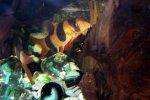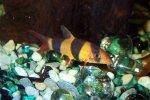Comprehensive Guide to Caring for Clown Loach (Chromobotia macracanthus): Habitat, Diet, Behavior, and Health
Quick Links - Answers
Brief Description
This guide covers everything you need to know about the Clown Loach, from tank setup to feeding and disease prevention. If you have any questions or personal experiences with Clown Loaches, share them in the comments at the bottom of this page. For additional information, visit the Clown Loach Profile Page, which includes a forum for community discussions.
The Clown Loach (Chromobotia macracanthus) is one of the most popular tropical freshwater fish in the aquarium hobby. Its bright orange body adorned with bold black stripes makes it a standout addition to any tank. Native to the rivers and streams of Southeast Asia, this bottom-dwelling species is well-known for its playful behavior, peaceful nature, and social tendencies.
Habitat and Natural Environment
Clown Loaches originate from the warm, fast-flowing rivers of Sumatra, Borneo, and the Sunda Islands. In the wild, they thrive in water temperatures ranging between 77°F to 86°F (25°C to 30°C) and prefer slightly acidic to neutral water with a pH of 6.0-7.5. These regions are characterized by rocky substrates, dense vegetation, and strong currents.
When recreating their natural environment in an aquarium, it’s essential to provide them with similar conditions, including clean, oxygen-rich water and plenty of hiding spots created with plants, driftwood, and rocks.
Sexing and Breeding
Distinguishing between male and female Clown Loaches is challenging, especially when they are young. However, adult females tend to be bulkier and rounder, particularly during the breeding season. Breeding Clown Loaches in captivity is rare, and it can take years for them to reach sexual maturity, making larger, sexually mature specimens both expensive and hard to find in stores.
While some hobbyists have reported occasional breeding in home aquariums, it is uncommon, and Clown Loaches typically require specific environmental triggers, such as seasonal temperature and water changes, to initiate spawning.
Diet and Feeding Tips
Clown Loaches are omnivorous, meaning they consume both plant matter and protein-based foods. In the aquarium, they should be offered a varied diet to ensure they receive the necessary nutrients for optimal health. Their diet can include:
- Meaty foods: Clown Loaches are fond of live or frozen brine shrimp, bloodworms, and chopped beef hearts. They also enjoy consuming snails, making them excellent for controlling snail populations in tanks.
- Vegetables: Be sure to provide them with plant-based foods such as zucchini, spinach, and blanched peas to balance their diet.
- Prepared foods: High-quality sinking pellets, algae wafers (especially those containing Spirulina), and flake foods can serve as a staple diet.
Feed them multiple small meals throughout the day rather than one large feeding, as they are active foragers. Their barbels (small whisker-like appendages) help them locate food by digging through substrate.
Clown Loach Behavior
Clown Loaches are highly social fish known for their playful and active behavior. They thrive in groups of at least six and enjoy interacting with each other through various forms of group swimming and playful sparring. In the absence of companionship, they can become shy, reclusive, or even stressed, so it’s vital to keep them in schools to maintain their mental and physical health.
Some of the unique behaviors of Clown Loaches include:
- Playing dead: Clown Loaches sometimes lie motionless at the bottom of the tank, which may alarm new owners. However, this is normal behavior and not a sign of illness.
- Upside-down swimming: It's not uncommon to see Clown Loaches swimming upside-down while exploring their environment.
- Jumping: They are known to jump out of the water occasionally, so it’s essential to have a secure tank lid to prevent accidents.
Clown Loaches are generally peaceful but may engage in harmless sparring to establish social hierarchy. They may also “click” or produce audible sounds during feeding or social interactions.
Tank Requirements and Setup
Clown Loaches can grow up to 12 inches (30 cm) in length, making it important to provide a spacious tank with proper water quality and swimming space. For long-term health, follow these guidelines for their tank setup:
- Tank size: A minimum tank size of 75 gallons (284 liters) is recommended for a group of Clown Loaches, with larger tanks preferred as they grow. These active swimmers need plenty of open space, as well as hiding places created with driftwood, rocks, and caves.
- Water flow: Clown Loaches prefer fast-flowing water, so ensure you have a strong filtration system, such as a canister filter, to maintain water movement and oxygenation. Powerheads can also help create a current to simulate their natural environment.
- Water quality: Keep the water clean with regular water changes of 20-30% weekly. The water temperature should remain between 77°F-86°F (25°C-30°C), and the pH should be stable between 6.0 and 7.5.
- Substrate: Use smooth, soft substrates like sand or fine gravel to prevent damage to their sensitive barbels.
Common Diseases and Treatment
Clown Loaches are particularly susceptible to Ichthyophthirius multifiliis (Ich), a parasitic disease that presents as white spots on the fish’s body and fins. Due to their nearly scale-free bodies, Clown Loaches are especially sensitive to medication, so caution is needed when treating diseases.
Ich Treatment: The safest way to treat Ich in Clown Loaches is by raising the tank temperature to 86°F (30°C) for about 5-7 days. This speeds up the life cycle of the parasite and helps eradicate it. Always monitor water conditions closely during treatment, and use medications labeled as safe for scaleless fish if necessary.
Prevention is always better than cure, so maintaining good water quality and avoiding sudden changes in water parameters can help reduce the risk of diseases.
Note
Clown Loaches are not recommended for beginner aquarists due to their size, specific water needs, and susceptibility to diseases. However, for those with established tanks and experience, they make an excellent addition to any large, peaceful community aquarium.
Pictures
References
- Aquarium Fishes of the World by Dr. Herbert R. Axelrod, Dr. Warren E. Burgess, Neal Pronek, Glen S. Axelrod, and David E. Boruchowitz









